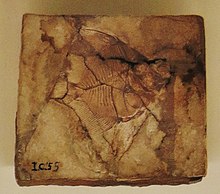Halterfish
| Halterfish | ||||||||||||
|---|---|---|---|---|---|---|---|---|---|---|---|---|

Halterfish ( Zanclus cornutus ) |
||||||||||||
| Systematics | ||||||||||||
|
||||||||||||
| Scientific name of the family | ||||||||||||
| Zanclidae | ||||||||||||
| Bleeker , 1877 | ||||||||||||
| Scientific name of the genus | ||||||||||||
| Zanclus | ||||||||||||
| Cuvier , 1831 | ||||||||||||
| Scientific name of the species | ||||||||||||
| Zanclus cornutus | ||||||||||||
| ( Linnaeus , 1758) |
The halterfish ( Zanclus cornutus ; Hawaiian kihikihi ) occurs in the coral reefs of the tropical Indo-Pacific to a depth of 180 meters. Its distribution area extends from East Africa to Rapa and Ducie , north to southern Japan and Hawaii , south to Lord Howe Island . In the eastern Pacific it occurs from the southern Gulf of California to Peru . The halter fish family (Zanclidae) is monotypical , that is, it contains only one genus and this only one species.
features
The 22 centimeter long fish has many anatomical features in common with the surgeon fish , but it lacks the scalpels on the tail stalk. Its body is disk-shaped (or actually sickle-shaped, from gr. Ζἀγκλη sickle ), the snout is small and elongated. The first rays of the dorsal fin are elongated into a flag-like filament, which, together with its black and white banding , gives it a resemblance to the banner fish , to which it is, however, not closely related. The species name (Latin: horned ) refers to an over-eye sting, which is only evident in sexually mature individuals.
- Fins formula : dorsal VI – VII / 39–43, anals III / 31–37.
- 22 vertebrae.
- 14 pyloric tubes .
Way of life
Halters inhabit lagoons, rocky and coral reefs with high currents. They usually appear in pairs, in small groups of two to three specimens, or occasionally in flocks.
They feed on sponges , bog animals , other sessile invertebrates and algae . For this purpose, the jaws are covered with long, thin brush teeth. They spawn in the evening hours, then rise in pairs to the surface of the water and release their pelagic eggs. A long larval stage is the reason for the wide distribution of the halter fish. With a length of 7.5 centimeters, the animals transform from the post-larval stage to young fish.
Halters are occasionally imported for keeping in saltwater aquariums . As nutrition specialists, however, they usually starve to death after a few weeks.
Fossil record
The fossil halterfish Eozanclus brevirostris is known from the middle Eocene of the northern Italian Monte Bolca formation, which was formed from deposits of the Tethys .
Trivia
The cartoon character Khan from the Pixar Animation Studios film Finding Nemo is a halter fish.
literature
- Joseph S. Nelson : Fishes of the World. Wiley, New York 2006, ISBN 0-471-25031-7 .
- Hans A. Baensch , Helmut Debelius , Horst Moosleitner: The common care of invertebrates and tropical marine fish in the aquarium. Mergus, Melle 1997, ISBN 3-88244-110-0 ( Sea Water Atlas. Volume 1).
Individual evidence
- ^ Kihikihi in Hawaiian Dictionaries
- ^ Karl Albert Frickhinger: Fossil Atlas of Fishes. Mergus, Melle 1999, ISBN 3-88244-018-X
Web links
- Halfterfisch on Fishbase.org (English)
